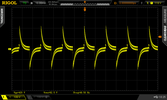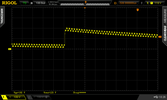I’ve bought the inverter for cheap in the outlet. As I assumed it’s not fully working, I decided to have a look first.
The case is a nice finned aluminium, acting as a big heatsink. There are 8 screws holding the case together and few more for the transistors. One part of the case goes off easily. The PCB slides into the bottom case nicely.
The PCB inside looks nice and clean, it’s based on the standard KA7500 chip (there are two of them), there are two groups of four power transistors, each group on the opposite side of the case. Wires for the 12V input are pretty beefy (and inflexible). Only the fuse holders seem a bit fishy. I decided to investigate and found out they are in fact female Faston connectors soldered in a PCB! They are bent, and one of them is not soldered in place at all. It was an easy fix and everything else seems to be good to go.
Using the unit
| Official specs | |
|---|---|
| Input voltage | 11-15V DC |
| Max input current | 49A |
| Output voltage | 230V AC +-5%, 50Hz |
| Max output current | 2.2A (*230V = 506W) |
| Efficiency | ≥85% |
| Standby input current | ≤0.5A (*12V = 8.4W) |
After completing the unit back, it works just fine. The specs seem pretty nice, it is designed to work from car battery, and has undervoltage warning specified somewhere around 10-11V, and efficiency of 85%. The standby input current is not specified in the brochure, but the official website says 0.5A.
Let us see how these specs hold. I’ve tested with my Manson HCS-3200 power supply. Unfortunately, it only goes to 20A, which is just under half max load. I’ll get a battery for testing later.
After powerup, the device consumes 0.7A at 12V, that is 8.4W. My Manson was a bit confused by the inverter under load, and did not show current correctly, and I was unable to measure efficiency with any relavant precision. The undervoltage protection is realised by really loud and annoying buzzer, and triggers just under 10.5V. On the other hand, the fan is reasonably quiet and only starts under a load.
The inverter claims to output modified sine wave. Here is the actual output; I wonder why my Fluke 45 failed to measure the AC voltage.
Although it does not resemble the sine wave, it is stable under load and works fine with my old soldering iron and my notebook adapter.


